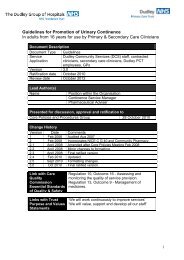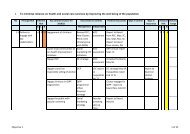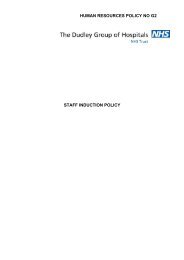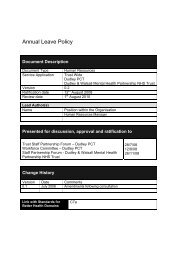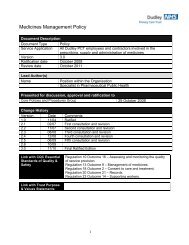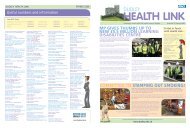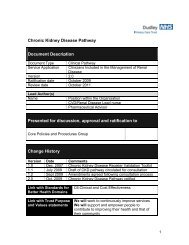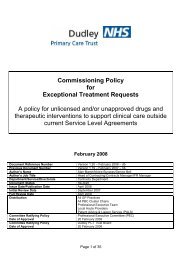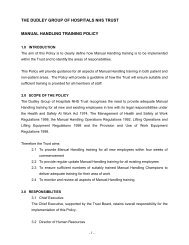Dudley Strategy for Tackling Health Inequalities 2010-15
Dudley Strategy for Tackling Health Inequalities 2010-15
Dudley Strategy for Tackling Health Inequalities 2010-15
- No tags were found...
You also want an ePaper? Increase the reach of your titles
YUMPU automatically turns print PDFs into web optimized ePapers that Google loves.
data which shows us locally what access parents across the social gradient have topaid parental leave during the first years of their children‟s life.Early Years: What Needs to be Done in <strong>Dudley</strong>?While data systems exist to look at progress, at a population level, on immunisation,breast feeding, and attainment at reception year of primary school, there are nosystems which enable the full picture to be obtained of the developmental progressof our children in the vital early years. Equally, the systems <strong>for</strong> tracking fidelity to the<strong>Health</strong>y Child Programme and fidelity to important <strong>for</strong>mal manual-based parentingprogrammes does not exist. Undoubtedly, each individual child‟s progress isrecorded in a health, education or children‟s centre record but the systems to extractthis and examine progress across the child population as a whole or <strong>for</strong>disadvantaged sub-groups of the population is not there. This is a priority <strong>for</strong>development. It is not a small job and will require time to implement. Nevertheless,we will not be able to assess whether our interventions in early years are producingthe outcomes we desire if we do not have systems to allow us to view progress.It has not been possible in the timescale <strong>for</strong> production of this strategy to amass dataon the relative spend on children in the early years versus spend on the school yearsand the adolescent years in <strong>Dudley</strong>. Marmot (<strong>2010</strong>) acknowledged that this is notwholly possible at national level either. However, it should be possible to at leastreproduce <strong>for</strong> <strong>Dudley</strong> an analysis of the type presented in the national data in theMarmot Review. It is recommended that investment in school and adolescent yearsshould be examined to see if there is any way in which efficiency can be improved torelease resource to be invested in the vital early years.<strong>Dudley</strong> has no structured intensive home visiting service, such as that deliveredwithin a Family Nurse Partnership Programme. This is essential <strong>for</strong> some families.Any investment released from other areas <strong>for</strong> early years should be channelled intothe commissioning of a Family Nurse Partnership Programme <strong>for</strong> families on adefined set of eligibility criteria, with a clear means of auditing outcomes.The structured approach to implementation of <strong>for</strong>mal parenting programmes set outin <strong>Dudley</strong>‟s Parenting Support and Family Learning <strong>Strategy</strong> (<strong>Dudley</strong> Children‟sTrust, 2009) should continue but with full tracking of adherence to eligibility criteriawhich ensure that those who need them most get them Impact in terms of outcomemeasures must be tracked.Undoubtedly, productivity would be improved and potentially some resourcereleased, if there was more <strong>for</strong>mal integrated working between the <strong>Health</strong> Visitingservice and the Children‟s Centres, particularly between the outreach workers and<strong>Health</strong> Visitors.Ensuring that paid parental leave is available <strong>for</strong> workers within <strong>Dudley</strong> may not bewithin the compass of the statutory agencies to deliver, but all statutory agenciesshould ensure that their own policies embrace this and economic regenerationinitiatives should promote this.32




